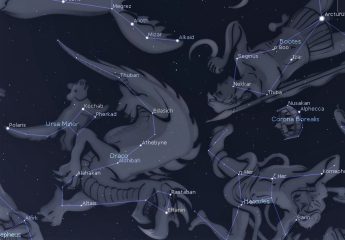This Week’s Sky at a Glance, 2024 May 18 – May 25
This Week’s Sky at a Glance, 2024 May 18 – May 25
By 10 pm the zigzag constellation of Draco the Dragon is halfway up the northern sky to the right of the Little Dipper. Draco’s tail is a line of stars between the Big and Little Dippers. One of those stars is Thuban, which lies between the bowl of the Little Dipper and the middle of the Big Dipper’s handle. About 5000 years ago, when the Egyptian pyramids were built, Thuban was the North Star and entrances to the pyramids were designed with a descending passageway aligned to this star. Coincidentally, the inner two stars of the Big Dipper’s bowl point to Thuban, just as the outer pair points toward Polaris.
From the tail, Draco arcs around the bowl of the Little Dipper and then curves back toward Hercules, with its head being a quadrilateral of stars by the strongman’s foot. The two brightest stars in Draco’s head, Eltanin and Rastaban, are its eyes. They are the brightest and third brightest of the constellation. The faintest of the four is a treat in binoculars, showing matching white stars that resemble headlights or cat eyes. In mythology the dragon was one of the Titans, rivals of the Olympians. In one of their battles, Athena slung the dragon high into the northern sky. Writhing to right itself, it struck against the northern sky and froze in that position.
This Week in the Solar System
Saturday’s sunrise in Moncton is at 5:42 and sunset will occur at 8:49, giving 15 hours, 7 minutes of daylight (5:50 and 8:51 in Saint John). Next Saturday the Sun will rise at 5:36 and set at 8:56, giving 15 hours, 20 minutes of daylight (5:44 and 8:58 in Saint John).
The Moon is full and rises just to the right of Antares in Scorpius before 10 pm on Thursday. Over the next couple of hours it slides below that red supergiant star. Mars sits 10 degrees above the eastern horizon at 5 am this weekend, with Saturn a hand span to its upper right. Mercury is rising around that time all week, 40-45 minutes before sunrise. Jupiter is in solar conjunction this Saturday, International Astronomy Day, and it has a close conjunction with Venus on Thursday but they are too close to the Sun to be seen. Astrophotographers might want to try for comet P12/Olbers near the M36 star cluster in Auriga on Tuesday.
On Sunday evening at 8 pm, tune in to the Sunday Night Astronomy Show via the Facebook page or YouTube channel of Astronomy by the Bay.

